Our editors independently select these products. Making a purchase through our links may earn Well+Good a commission
This is a staggering statistic, so brace yourself: 90 percent of visible aging of the skin is a direct result of prolonged sun exposure. It’s estimated that one in five Americans will develop skin cancer in their lifetime. The American Cancer Society recommends using a broad-spectrum sunscreen (meaning it protects against both UVA and UVB radiation), with an SPF of at least 30. If there is *one* thing you do for your face, get a good sunscreen, say dermatologists. One easy and quick way to get sun protection is a sunscreen spray for your face.
Experts in This Article
board-certified dermatologist and founder of KP Away
board-certified dermatologist and resident advisor to Dermstore
celebrity esthetician and owner of Sarah Akram Skincare
Best Spray Sunscreens for Your Face At a Glance
- Best overall: Vacation, Super Spritz SPF 50, $24
- Best chemical: La Roche Posay Anthelios Spray SPF 60, $27
- Best mineral: HydroPeptide Solar Defense Mineral Spray SPF 30, $48
- Best over makeup: Naked Sundays SPF 50 Hydrating Glow Mist Top Up, $30
- Best vegan: Coola Classic Face Sunscreen Mist SPF 50, $32
- Best hydrating: Soleil Toujours Clean Conscious Set + Protect Micro Mist SPF 30, $42
- Best for sensitive skin: Blue Lizard Sensitive Mineral Sunscreen Spray SPF 50, $20
- Best refreshing: Supergoop Resetting Refreshing Mist SPF 40, $34
- Best splurge: Cosmedix Protect UV SPF 30, $63
- Best matte: Kate Somerville UncompliKated SPF 50 Setting Spray, $44
- Best unscented: Seriously Fab Zinc It Over Unscented SPF Mist, $44
- Best scented: Habitat No. 41 Mister SPF 40, $30
- Best calming: Coola Setting Spray SPF 30, $36
- Best budget: Sun Bum Original SPF 45 Sunscreen Face Mist, $13
How To Choose the Right SPF Spray Sunscreen for Face
The sun protection factor (SPF) is the level of protection the sunscreen provides against UVB rays. So, higher SPF mean more protection. But the higher you go, the smaller the difference becomes. For example, SPF 15 sunscreens filter out only about 93 percent of UVB rays, whereas SPF 30 sunscreens filter out 97 percent, and SPF 50 sunscreens filter out 98 percent.
Bottom line? You want an SPF of at least 30, minimum. And absolutely avoid “tanning sunscreen sprays” with low SPFs like 15. Anything below 30 is not recommended by the American Cancer Society. But bear in mind that after 60 the margins of protection become slimmer.
The Difference Between Physical and Chemical Sunscreens
And then there’s physical versus chemical sunscreens. We reached out to renowned celebrity esthetician Sarah Akram to explain the difference. “Physical sunscreens sit on top of the skin and reflect the sun’s rays, while chemical sunscreens absorb the rays and convert them into heat.” Spray sunscreens, which we’re talking about here, are often chemical sunscreens. Both types are helpful, but it should be noted that face sprays alone aren’t sufficient. You do need to also apply an all-over body physical sunscreen to adequately protect you from ultraviolet radiation.
How To Apply Spray Sunscreen for Face
“I wouldn’t rely on face sprays as your only source of daily SPF,” says Akram. “However I would recommend using them throughout the day as a refresh to your physical block.”
Anar Mikailov, MD, board-certified dermatologist and founder of KP Away, agrees. “Think of face spray sunscreens as a setting spray after makeup and reapplication throughout the day,” says Dr. Mikailov. “You should still apply an SPF in a cream form liberally to your face, back of neck and ears before applying makeup.”
To apply a spray sunscreen to your face, hold the bottle 4 to 6 inches away from your skin and spray generously. Don’t forget to rub it in, like you would a lotion sunscreen. “Sunscreen is most effective when rubbed in,” says Akram. “So once you spritz it on, it’s important to work it into the skin with your hands.” Also, and here’s where most people fail…the key is to reapply. “Most people aren’t applying enough sunscreen to get the full SPF protection on the label,” says Dr. Mikailov. “Apply generously and reapply after every 90 minutes,” especially if you’re going to be swimming or sweating.
Finally, the best sunscreen is the one you will use the most. Different skin types have different needs, so find the one that is best for you and consult with your dermatologist if you have any specific concerns or questions.
Ahead, your ultimate guide to spray sunscreen for your face with the dermatologist and esthetician stamps of approval. Also check out our tested sunscreens here.
The Best Spray Sunscreens for Your Face

Vacation, Super Spritz SPF 50 — $24.00
Derm-developed, this newly launched face mist is all we want to use this summer. Thanks to its moisturizing skin-care ingredients (like aloe, cucumber, and shea oil), every application feels like we’ve infused our complexion with deep hydration that leaves our face perfectly dewy and satiated. It checks off all the functional boxes, too: It’s water-resistant up to 80 minutes, it’s Hawaii Reef Compliant, so you can pack it on your beach vacation and know that it’s ocean-friendly, and it’s PEG and Paraben-free.
Type: Chemical
SPF: 50
Size: 2.2 oz.
Active Ingredients: avobenzone, octisalate, octocrylene
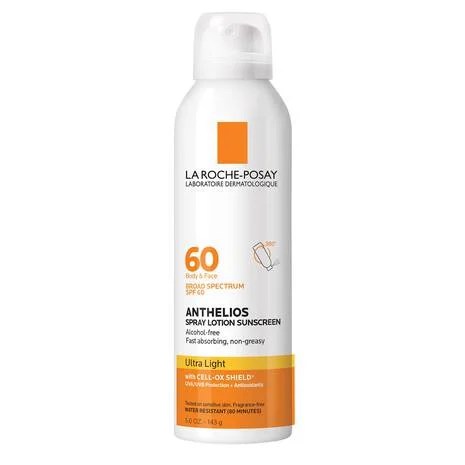
Best chemical: La Roche Posay Anthelios Spray SPF 60 — $27.00
“This is a universal spray for face and body, so it’s a two-in-one,” says Akram. “It’s fragrance-free and alcohol-free, and it’s great if your skin is on the sensitive side since it’s lightweight and non-greasy.” And it’s formulated with Cell-Ox Shield technology, meaning it gives broad spectrum UVA/UVB protection with antioxidants.
Type: Chemical
SPF: 60
Size: 5 oz.
Active ingredients: Avobenzone, homosalate, octisalate, octocrylene, oxybenzone
Pros:
- Alcohol-free
- Lightweight
- Water-resistant
Cons:
- Some reviewers say it leaves a slight white cast
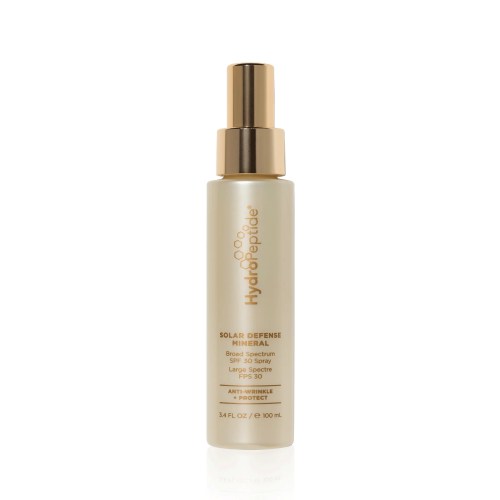
Best mineral: HydroPeptide Solar Defense Mineral Spray SPF 30 — $48.00
“I’m a fan of aloe in sunscreens, because it helps with post-sun exposure inflammation,” says Ashley Magovern, MD, a board-certified dermatologist and resident advisor to Dermstore. “The hyaluronic acid in this product makes the skin look and feel hydrated. And sunflower oil is also a great ingredient for boosting the skin’s barrier. And I love that it’s a mineral sunscreen with zinc oxide.”
Type: Mineral
SPF: 30
Size: 3.4 oz.
Active ingredients: Zinc oxide
Pros:
- Contains aloe and hyaluronic acid
- Scent-free
- Lightweight
Cons:
- May leave a white cast
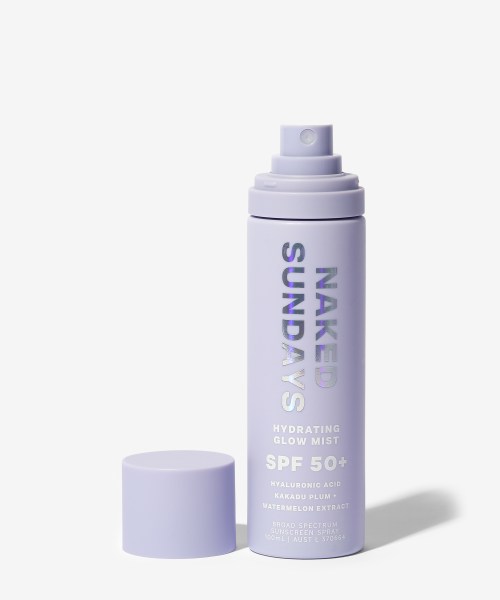
Best over makeup: Naked Sundays SPF 50 Hydrating Glow Mist Top Up — $30.00
This face mist is excellent for using as a makeup setting spray or for reapplication, because it doesn’t leave a “white cast,” meaning that visible milky film you can often get after using SPF. “This spray from Naked Sundays is packed with Vitamin C and Vitamin E, and it leaves a nice dewy finish when used on top of makeup,” says Dr. Mikailov.
Type: Chemical
SPF: 50+
Size: 3.4 oz.
Active ingredients: Avobenzone, homosalate, octilsalate, octocrylene 8%
Pros:
- Sets makeup
- Contains antioxidants
- Non-comedogenic
Cons:
- Not water-resistant
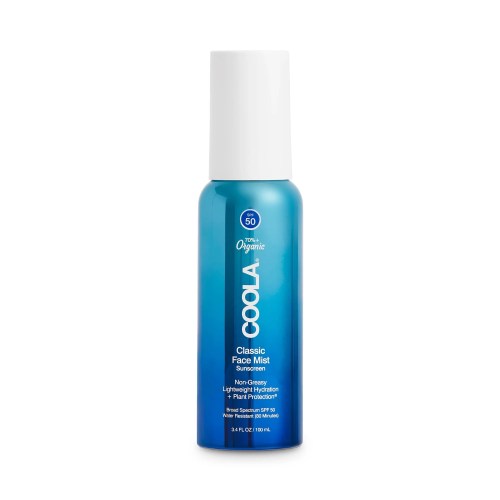
Best vegan: COOLA Classic Face Sunscreen Mist SPF 50 — $32.00
If you’re looking for something to put in your gym bag after a particularly sweaty workout, this face mist from Coola with an SPF of 50 is a great pick. “It’s non-greasy, organic, vegan and it contains antioxidant-rich ingredients like green tea extract and buriti oil, which is a plant-based oil extracted from Amazonian palm trees,” says Akram.
Type: Chemical
SPF: 50
Size: 3.4 oz.
Active ingredients: Avobenzone, octisalate, octocrylene
Pros:
- Lightweight
- Water-resistant
- Contains antioxidants
Cons:
- Has a stronger scent
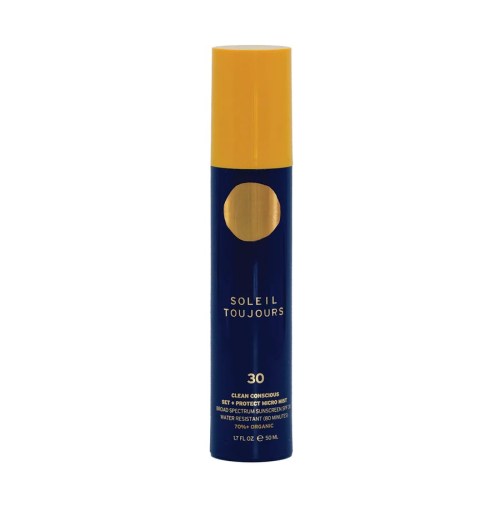
Best hydrating: Soleil Toujours Clean Conscious Set + Protect Micro Mist SPF 30 — $42.00
“This sunscreen is packed with ingredients like aloe extract, green tea leaf extract and sodium hyaluronate to help calm and hydrate skin,” says Akram. And as an added bonus the bottle is really pretty– which is rare for sunscreens, which typically come in more clinical packaging.
Type: Chemical
SPF: 30
Size: 1.7 oz.
Active ingredients: Avobenzone, homosalate, octisalate
Pros:
- Contains hyaluronic acid and vitamins C and E
- 70+ organic
- Water-resistant
Cons:
- Small size
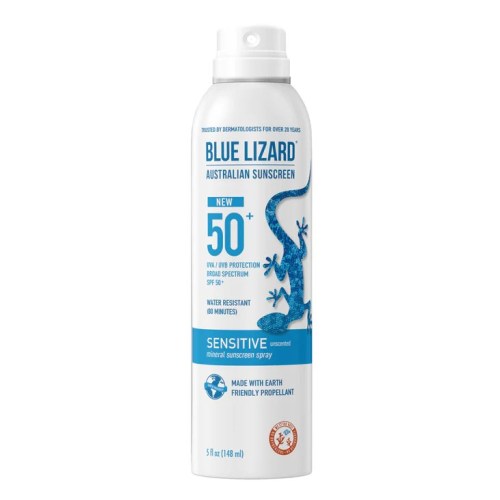
Best for sensitive skin: Blue Lizard Sensitive Mineral Sunscreen Spray SPF 50 — $20.00
“This mineral sunscreen features a continuous spray rather than a pump,” says Dr. Mikailov. “But you should still apply on your hands first, instead of spraying it directly onto your face.” This helps you to avoid spraying in your eyes or nostrils. “It’s ideal for sensitive skin since it’s mineral-based, unscented and water-resistant.”
Type: Mineral
SPF: 50+
Size: 5 oz.
Active ingredients: Zinc oxide
Pros:
- Fragrance- and alcohol-free
- Water-resistant
- Contains antioxidants
Cons:
- Some reviewers say it doesn’t absorb well

Best refreshing: Supergoop Resetting Refreshing Mist SPF 40 — $34.00
“For those who wear makeup, this is another two-in-one option,” says Akram. “It’s meant to set your makeup, and it gives a matte, yet hydrating finish. “And it’s formulated with field mustard and tung oil, natural ingredients that create a breathable film on the skin to help filter pollution.” It has a light rosemary and mint fragrance to give you a boost of energy when you need it.
Type: Chemical
SPF: 40
Size: 3.4 oz.
Active ingredients: Avobenzone, homosalate, octisalate, octocrylene 9.5%”
Pros:
- Lightweight
- Water- and sweat-resistant
- Sets makeup
Cons:
- Some reviewers say it feels oily
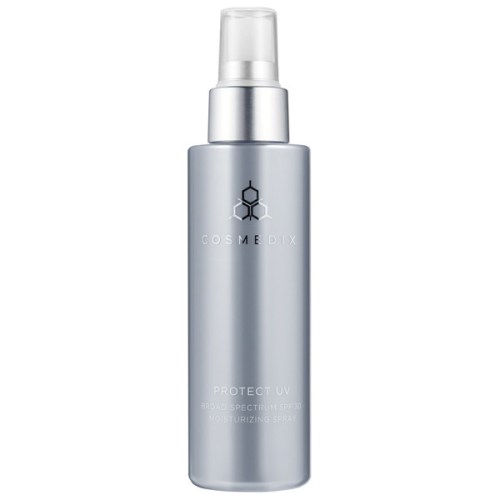
Best splurge: Cosmedix Protect UV SPF 30 — $63.00
“I love this spray sunscreen because it’s formulated with niacinamide, a form of vitamin B, which can improve and help restore your skin’s barrier function after sun exposure,” says Dr. Magovern. And while it’s on the pricier side, you can use it all over your body, in addition to your face.
Type: Chemical
SPF: 30
Size: 4 oz.
Active ingredients: Titanium dioxide
Pros:
- Oil-free
- Contains vitamin B and green tea extract
- Lightweight
Cons:
- Expensive

Best matte: Kate Somerville UncompliKated SPF 50 Setting Spray — $44.00
“This SPF spray has a continuous spray,” says Dr. Mikailov. “But it’s a lighter mist, so it’s okay to apply directly on the face first and then rub it in. And it’s excellent for giving a very even coverage, unlike some spray sunscreens.” It’s also formulated with silicone powder, which gives a matte finish.
Type: Chemical
SPF: 50
Size: 3.4 oz.
Active ingredients: Avobenzone, homosalate, octisalate, octocrylene, oxybenzone
Pros:
- Matte finish
- Contains hyaluronic acid
- Sets makeup
Cons:
- Some reviewers say it has a strong scent
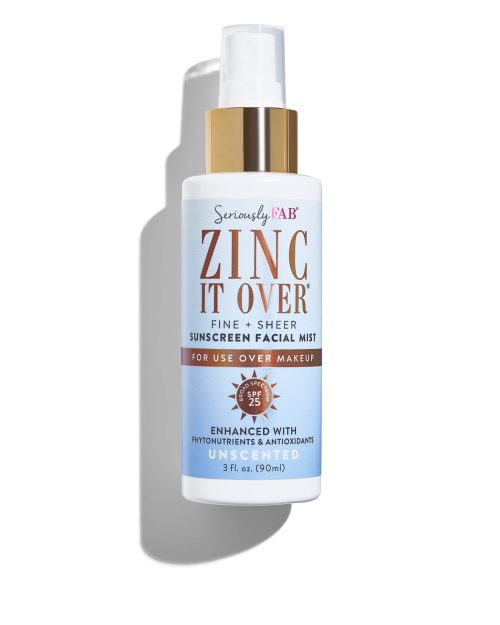
Best unscented: Seriously Fab Zinc It Over Unscented SPF Mist — $44.00
“This is designed to be worn over makeup, and it has mineral sunscreen protection with zinc oxide,” says Dr. Magovern. “It’s packed with ingredients that are antioxidants and sun-protectors like aloe, blue green algae extract, pomegranate, and pumpkin seed extract–which can help prevent acne breakouts.”
Type: Mineral
SPF: 25
Size: 3 oz.
Active ingredients: Zinc oxide
Pros:
- No added fragrance
- Can be used over or under makeup
- Contains antioxidants and vitamins
Cons:
- Lower SPF
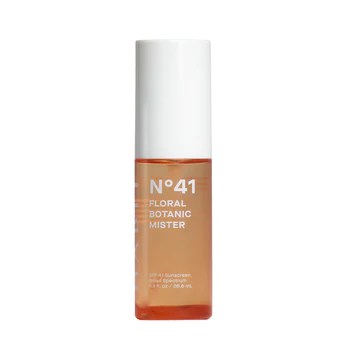
Best scented: Habitat No. 41 Mister SPF 40 — $30.00
“This spray is lightweight with a very fine mist and a quick set,” says Akram. And with top notes of rose geranium and secondary notes of lavender and rosemary, “this is a great option for anyone who likes natural fragrances and herbal-forward scents.”
Type: Chemical
SPF: 41
Size: 0.9 oz.
Active ingredients: Avobenzone, homosalate, octisalate, otocrylene 9.5%,
Pros:
- Lightweight
- Botanical scent
Cons:
- Some reviewers say it feels greasy

Best calming: Coola Setting Spray SPF 30 — $36.00
This SPF setting spray gives a nice, matte finish after you’ve applied your makeup, and helps to blur imperfections. And it’s an excellent sunscreen for sensitive skin. “It’s lightweight and made with aloe and cucumber extract, which are very calming and cooling ingredients,” says Dr. Magovern.
Type: Chemical
SPF: 30
Size: 1.5 oz.
Active ingredients: Avobenzone, homosalate, octisalate
Pros:
- Contains aloe and cucumber extracts
- Lightweight
- Matte
Cons:
- Small size
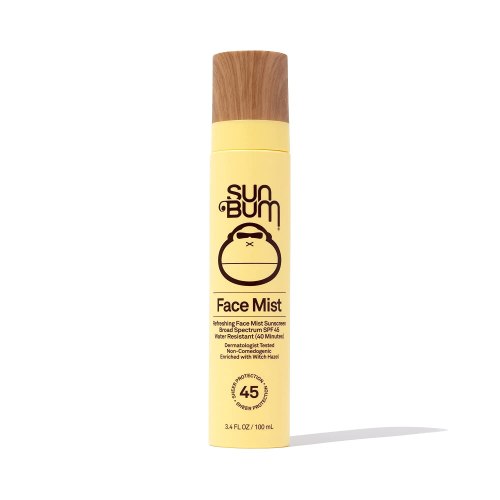
Best budget: Sun Bum Original SPF 45 Sunscreen Face Mist — $13.00
Sun Bum’s sunscreen face mist is lightweight, oil-free, and non-comedogenic. It contains witch hazel, which is an anti-inflammatory ingredient. The sunscreen is also oil-free and also water-resistant, so it’s as ready for the beach as you are. And the best part: the price point won’t break the bank.
Type: Chemical
SPF: 45
Size: 3.4 oz.
Active Ingredients: Homosalate, octocrylene, octisalate, avobenzone
Pros:
- Lightweight
- Affordable
- Water-resistant
Sign up for the Well+Good SHOP Newsletter
Get exclusive deals on wellness, beauty, fitness, and food products that have been hand-picked by our editors.
Got it, you've been added to our email list.











